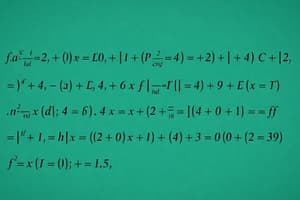Podcast
Questions and Answers
What is the defining characteristic of a continuous function at a point?
What is the defining characteristic of a continuous function at a point?
- The limit as x approaches a certain value is equal to the function value at that point (correct)
- The function is increasing at that point
- The derivative at that point is zero
- The function takes on integer values at that point
How are limits of trigonometric functions typically evaluated?
How are limits of trigonometric functions typically evaluated?
- By looking at their definitions (correct)
- By factoring the functions
- By using algebraic manipulations
- By applying the chain rule
For what type of functions, like exponential and logarithmic functions, can limits be evaluated using their properties?
For what type of functions, like exponential and logarithmic functions, can limits be evaluated using their properties?
- Rational functions
- Polynomial functions
- Trigonometric functions
- Exponential and logarithmic functions (correct)
Which type of limit does not exist, as shown in the text?
Which type of limit does not exist, as shown in the text?
What happens to \(\frac{e^x - 1}{x}\) as x approaches 0?
What happens to \(\frac{e^x - 1}{x}\) as x approaches 0?
Flashcards are hidden until you start studying
Study Notes
Applied Maths Class 11: Exploring Limits
Limits are a fundamental concept in calculus that help us navigate the nuanced and intricate world of functions. In Applied Maths 11, limit theory lays the foundations for understanding the behavior of functions as inputs approach certain values. This article aims to demystify the ideas of limits and their applications, while making it as easy and fun to learn as possible!
What is a Limit?
When we say that the limit of a function as the input approaches a certain value is a specific number, we're saying that the function values get closer and closer to that number as the input approaches the value in question. The formal definition is:
The limit of a function as its input approaches a certain value is the number the function values approach as the input approaches that value.
For example, consider the function (f(x) = \frac{x^2 - 1}{x - 1}). As (x) approaches 1, the function values approach 2:
[ \lim_{x \to 1} \frac{x^2 - 1}{x - 1} = 2 ]
Applications of Limits
Limits are a vital tool in calculus. They help us define the derivative and the integral, which allow us to find rates of change and areas under curves, respectively. Here are a few applications:
-
Derivatives: To find the derivative of a function, we look at the limit of the difference quotient as the input approaches zero.
-
Integrals: To find the area under a curve, we look at the limit of sums of the function values as the width of the rectangles approaches zero.
-
Continuity and Discontinuity: Limits help us determine whether a function is continuous at a point. If the limit as (x) approaches a certain value is equal to the function value at that point, then the function is continuous at that point.
Common Types of Limits
-
Limits of Constant Functions: These are straightforward: (\lim_{x \to c} k = k), where (k) is a constant.
-
Limits of Polynomial and Rational Functions: These can be evaluated using algebraic manipulations and factoring.
-
Limits of Trigonometric Functions: Limits of trigonometric functions can be evaluated by looking at their definitions or using the properties of trigonometry. For example, (\lim_{x \to 0} \frac{\sin x}{x} = 1).
-
Limits of Exponential and Logarithmic Functions: These can be evaluated using the properties of exponential and logarithmic functions. For example, (\lim_{x \to 0} \frac{e^x - 1}{x} = 1).
-
Limits that Do Not Exist: There are some limits that do not exist, such as (\lim_{x \to 0} \frac{x}{\sqrt{x}}), which approaches positive and negative values depending on the direction from which (x) approaches 0.
Conclusion
Limits are the foundation of calculus and are essential to deepening our understanding of functions. By learning how to evaluate limits and their applications, students can unlock a wealth of insights into the behavior of functions and their role in real-world problems. So dive into the world of limits and prepare to uncover the hidden beauty of calculus!
Studying That Suits You
Use AI to generate personalized quizzes and flashcards to suit your learning preferences.




